ChiS&E Program Exposes Chicago Public Schools Students to STEM...and Illinois
January 21, 2016

A ChiS&E youngster uses an i>clicker to vote for the professor he thinks won the Engineering Slam!
Instead of watching cartoons or sleeping in, several Saturday mornings a semester, 100+ Chicago Public School (CPS) 5th through 7th grade students can be found doing math and physics activities as part of Illinois' Chicago Pre-College Science and Engineering (ChiS&E) STEM enrichment program. Seeking to expose traditionally underserved students (and their parents) to STEM (Science, Technology, Engineering and Mathematics), ChiS&E is comprised of a number of Illinois faculty, staff, and students who also devote their Saturdays to work with these youngsters in hopes of increasing their interest in STEM—and possibly even STEM careers.
A collaborative University of Illinois effort, the Urbana (Illinois) and Chicago (UIC) campuses are partnering with the Chicago program for which Illinois’ ChiS&E program is named: the Chicago Pre-College Science and Engineering Program (ChiS&E). Illinois’ ChiS&E outreach offered STEM activities for four consecutive Saturdays in fall 2015; for the spring 2016 semester, activities are scheduled for six Saturdays. Held primarily in Chicago at UIC, sessions are jointly taught by both Illinois and UIC personnel as well as CPS teachers. On the final Saturday session each semester, the CPS participants make the trip south of I-80 to experience the Illinois campus via additional STEM activities and campus tours.
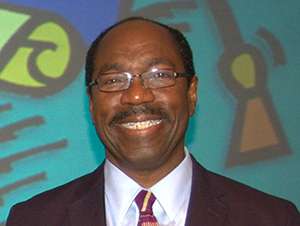
ChiS&E Founder and President, Kenneth Hill. (photo courtesy of ChiS&E website)
Begun by Kenneth Hill, ChiS&E was inspired by his previous experience running a similar highly regarded program in Detroit. Hill began ChiS&E in 2008 with Little Civil Engineer, which offered STEM activities for Kindergarteners; the program has added a grade a year since and hopes, with the University’s help, to eventually offer activities through 12th grade.
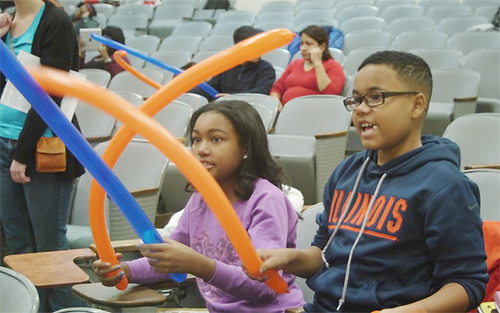
Two young visitors to Mosaic in fall 2014 play with balloons during the Fun with Iterative Balloon-Twisting workshop. (Photo courtesy of Matt Ando.)
Illinois’ Department of Mathematics’ was the first to get involved with the program. In 2013, Hill, began dialogue with the previous director of the Illinois Geometry Lab (IGL), Math Assistant Professor Jayadev Athreya, about adding a math component to the then K–4 program’s engineering emphasis.
So in both the spring and fall of 2014, the IGL did four consecutive Saturdays of enrichment activities with Chicago 5th and 6th graders. For the first Saturday, math grad students went to Chicago to lead activities, followed by two Saturdays at UIC where Illinois students interacted with ChiS&E participants via Skype. For the final Saturday of the program, the Chicago students bussed down to experience the Illinois campus.
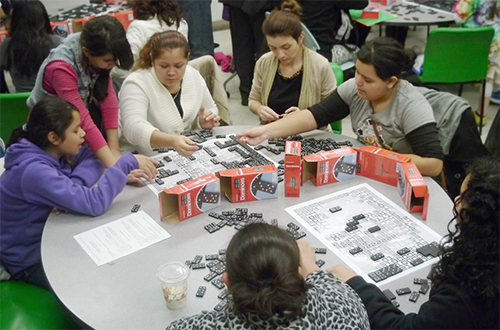
Visitors to Mosaic in fall 2014 build a mosaic out of dominos. (Photo courtesy of Matt Ando)
According to Matt Ando, head of the Math department: “In fall of 2014, we had nearly 100 Chicago Public Schools kids, plus their parents, in Altgeld Hall doing math activities and seeing other parts of campus. That part is very exciting.” Ando reports that students participated in the Mosaic Festival, plus saw an exhibit about math-related art in the Illini Union.
What kind of math activities are the youngsters doing? Aaccording to Ando, Math’s goal was not to duplicate what the kids are doing in school, but to do fun activities that “might get students excited about math.”
“It’s not just the stuff that they see in class everyday,” he says. “The things we developed for Chi Prep, they are the kinds of fun activities that introduce kids to small parts of college-level math.”
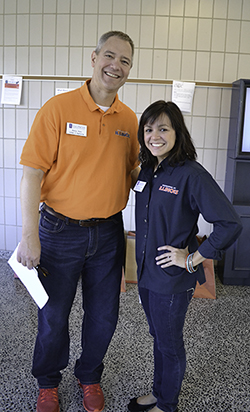
Left to right: Kevin Pitts, Engineering's Associate Dean for Undergraduate Programs and Sahid Rosado, Engineering's Outreach Coordinator
He adds, “The important thing was to give them some things to do with math that would hopefully seem to them both exciting and valuable.”
After laying a foundation in mathematics, Hill’s next phase was to solicit the College of Engineering to do physics-related activities. So Hill began dialoging with other key campus folk, including Engineering’s Associate Dean for Undergraduate Programs, Kevin Pitts, (a Physics Professor who is no slouch himself when it comes to exciting physics outreach) and Sahid Rosado, Engineering’s Outreach Coordinator, who was very involved with the nuts and bolts of the operation.
Taking particular interest in the program is Inga Karliner (whom this writer considers to be the heart and soul of the Physics Department). Always abreast of key Physics outreach, Karliner applauds Hill’s philosophy regarding the importance of math.
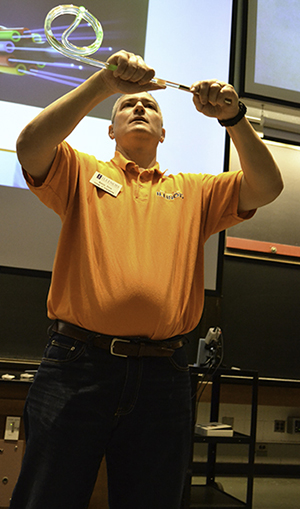
Above: Kevin Pitts demonstrates a device during the Engineering Slam!
Below: Jenny Amos tries to sell Bioengineering to the Chicago students during the Engineering Slam!

“The math skills are most important, and math really is a language. It’s like learning another language. So he knows that and he wants to provide serious enrichment in mathematics from K to 12.”
In addition to Hill’s math emphasis, Karliner also has high regard for the way his program exposes students to STEM early, then builds skills incrementally.
“So I think the two things that he’s understanding: that math is really important and that you that have to do it slowly. And they start with kindergarten and first grade, and each year, they added a year. You can’t just start in high school. Math, you have to build.”
So in Spring of 2015, Illinois’ ChiS&E outreach became multidisciplinary. In addition to Mathematics, Engineering/Physics got involved, who in turn reached out to a team of curriculum developers from the College of Education: Jana Sebastik and George Reese from MSTE and Adam Poetzel, a C&I professor in Math Education.
“We know what things we can do in terms of engineering,” admits Rosado, “but we also wanted to make it relevant for these kids to not only be exposed to engineering, but also to brush up on their skills as well. That’s when we were like, “Ok, we don’t really know what kids in the 7th grade do in terms of mathematics and physics. So it was kind of an obvious choice for us to reach out to the College of Education in terms of getting a curriculum in place.”
According to Rosado, a strength of ChiS&E is this cross-campus collaboration and multidisciplinary emphasis, which is reflected in the breadth of graduate students involved in mentoring:
“I think the key component to this program is definitely using our students, and I think the best part of it is that it’s not only engineering students. We had a mixture of engineering students; we had math majors; we had physics majors; we had elementary education students. So it’s this collaboration of so many departments, all having the same goal, which is to impact our youth. It was just beautiful to see that. To see that common goal among everyone was absolutely amazing.”
Having CPS teachers help teach ensured that even more CPS students would be impacted: “Our goal of having CPS teachers lead the sessions is that they can bring the curriculum into their own classrooms,” says Rosado. “We don’t want just the 60 kids to be exposed to this.”
Even the teachers learned some new things: “Some of the CPS teachers hadn’t used graphing calculators before,” which, according to Rosado “was good in a way because then we do know that we’re doing something that not only helps the kids but also helps the teachers.”
What most of the Illinois folk found exciting about ChiS&E was reaching out to students traditionally underrepresented in STEM. Rosado reports that 95% of the students participating in the program are either African American or Hispanic/Latino. Ando explains that this opportunity to serve the underserved was one reason why his department was eager to get involved:
“We thought that it was an investment in STEM education for kids that don’t normally get a lot of attention—that helping the pipeline of kids interested in Mathematics and Science, particularly minority kids, is a really important project,” says Ando. “We thought it was an important contribution to try to make…trying to increase the involvement of underrepresented populations in science and mathematics.”
Rosado appreciates that ChiS&E exposes underrepresented minorities to STEM:
“We are serving an underserved population here, and these are kids that don’t have opportunities to engage in curriculum like this in their own school, or they don’t have access to calculators. So just being able to give that access to these students is awesome. That was one of the things that really got me interested in this program was being able to do that.”
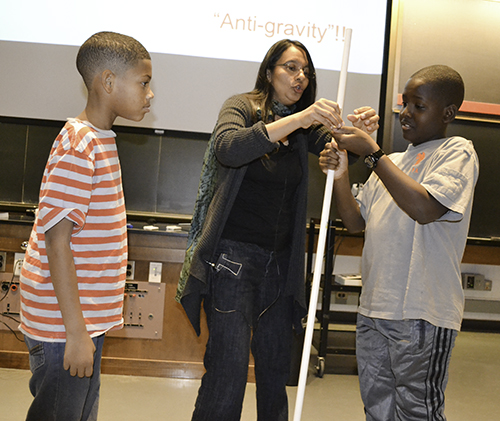
Two Chicago students help Illinois Physics Professor Smitha Vishveshwara demonstrate Anti-gravity during her presentation at the Engineering Slam!
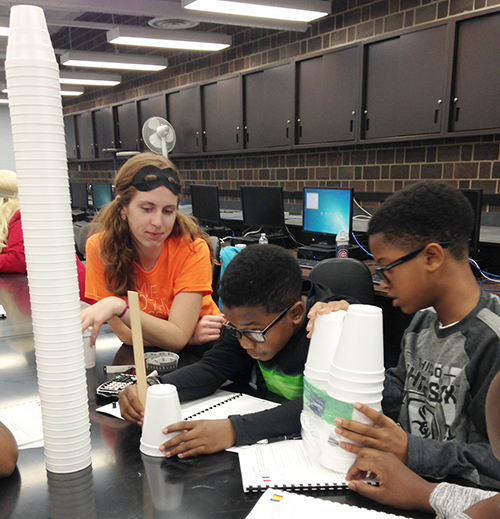
Illinois Engineering student Emily Matijevich (left) supervises while two Chicago students do a hands-on activity during one of the Fall 2015 ChiS&E workshops at UIC. (photo by Sahid Rosado)
In fact, Karliner believes a further impact of ChiS&E might be to increase diversity at Illinois:
“This is a really different thing. This seems to me that it has a potential to really make a difference, because it is really hard to work on diversity in the University and in the College of Engineering, and I think that this program is really promising. I think we can really have a great connection with under-privileged communities in Chicago and families that care about education, and they will hopefully apply either here or both here and other places.”
Another draw for many Illinois participants who day-in, day-out, face classrooms or lecture halls full of college-age students? Seeing a bunch of young faces in the crowd:
“It’s very exciting to be involved with kids this age,” Ando admits. “It’s not something that we normally get to do.”
Also excited about the age group ChiS&E is targeting, Karliner acknowledges that it’s the age when students tend to lose interest in STEM:
“Once the kids start getting in middle school (we know there’s research and books about it), we lose them; we lose them when they’re 11, 12, 13, and it’s really important not to do that.”
Getting kids hooked on STEM early might have additional perks. Ando and company admit that the possibility that some of these kids might end up going into math or even coming to Illinois has also crossed their minds.
“If we showed them that this is an exciting place and that math and science are exciting, some of them will grow up and go into math and science. But, in addition, some of those students will grow up and come to U of I.”
Rosado would also love to see these kids choose STEM fields: “Of course, I would love them to go into engineering, or be scientists, or be mathematicians. I think that would be awesome.”
However, her main motivation is to just give them opportunities they normally wouldn’t have: “But even just getting them exposed to all these wonderful concepts is enough for me,” she admits.
Something special the kids experienced in ChiS&E was a curriculum designed just for them, which Rosado calls “wonderful” and “super hands-on.” Also part of the fun…the kids got their hands on state-of-the-art graphing calculators:
“You had to see the kids on Saturday…it was the first time they were using graphing calculators. They were like, ‘Oh, my god!’”
Another of Rosado’s goals? To help each youngster understand that a career in STEM is actually an option.
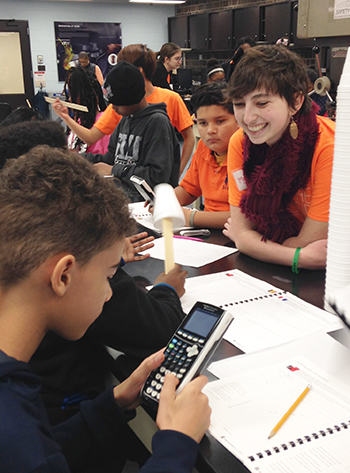
Clockwise from the right: An Illinois student looks on as a young Chicago student uses a graphing calculator. (photo by Sahid Rosado)
“Because even if they decide not to go into engineering, or not to go into science or math, as long as they know what it’s about, and as long as they make informed decisions about, ‘Okay, I know what it is, and I just don’t want to do it,’ I think that’s equally as awesome. So my hope and my goal with this program is really to do that for the kids, to give them access to things they normally don’t have access to. If they do end up in a STEM career, that’s a bonus. That’s like icing on top—the cherry on top.”
Like Ando and Rosado, Karliner also hopes ChiS&E influences some of its young participants to choose STEM careers.
“I think this is a great recruiting tool,” admits Karliner, “and what we’re hoping is that many of these kids really want to be going to college in engineering or science.”
Like Ando and Rosado, she also has high hopes that it will turn into a recruiting pipeline to Illinois: “They are getting really good math grounding, and they will presumably, once they get to be seniors, want to come here, and they will apply here.”
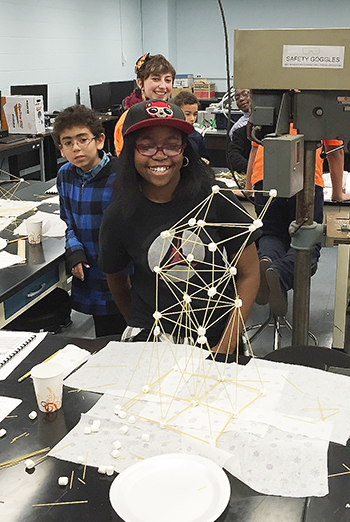
A student proudly displays the marshmallow-spaghetti structure she built during one of the fall 2015 workshops. (photo by Kevin Pitts)
On a mission to defeat Harvard in the recruiting wars, Karliner also hopes the program might give Illinois an edge with many of these students:
“So Harvard won’t steal them. Because that’s what happens now. You have some really promising young person, Harvard will offer them a full ride, so they go to wherever they are recruited, and I don’t blame them. And it’s not so much even the name, it’s the fact that private schools can now provide better financial help than state universities. Anyway, so there’s just going to be a bigger pool; they will also be somewhat attached to the college.”
In April of 2015, a number of Illinois folk traveled to Chicago to meet the 5th and 6th graders and their parents at a registration event...including the new University of Illinois President Timothy Killeen, who was there to welcome the families. Karliner shares an anecdote about Killeen’s presentation at the event.
“He just had two slides. One was for parents showing income levels depending on your education, and one was for kids. He was telling the kids, ‘You work very hard, and sometimes it’s tedious, but if you do science, you can do what I did,’ and showed them the slide when he’s in Antarctica, playing with penguins. So it was very appropriate, very short, and very touching.”
What do Illinois’ ChiS&E folks envision for the program in the future?
Citing GAMES Camp as a long-standing, successful Engineering outreach, Karliner says that down the road, there should be a summer camp. "Once the kids go to high school…The College has a lot of experience doing kids’ camps.”

An Illinois Engineering student interacts with two Chicago youngsters during a hands-on activity.
Ando says Math’s goals for the future include making the program sustainable and tweaking the curriculum to directly address the mathematics students do on standardized tests and/or in the classroom: “Developing a curriculum that really benefits them, and sustaining this for a substantial period of time—that’s a bigger challenge that we need to find resources to accomplish.”
Rosado reports that Engineering also envisions making the program sustainable, and is seeking funding to keep adding a year at a time for 8th grade on, and also to expand the program.
“We have definitely been talking about ways to scale it up, so not only kids in Chicago, but also kids here in our own community, as well as other towns within Illinois…We definitely would love to scale this where it’s a state-wide type of program, and we’re impacting hundreds of kids.”
Story and photographs by Elizabeth Innes, Communications Specialist, I-STEM Education Initiative.
More: K-6 Outreach, 6-8 Outreach, Chicago Public Schools, ChiS&E, Underserved Minorities, 2016
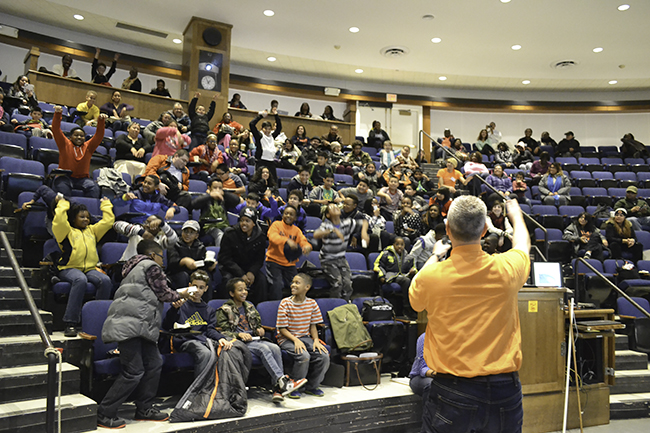
Kevin Pitts leads the students in "The Wave" during his Engineering SLAM! presentation about waves.
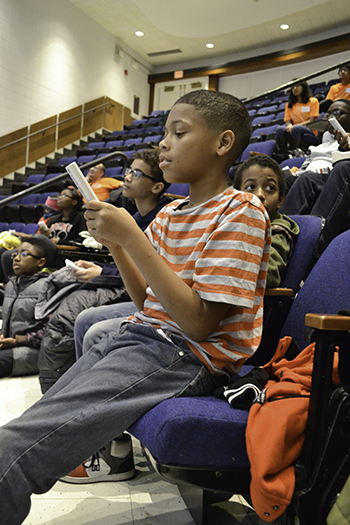
A Chicago youngster who visited campus for the fall 2015 campus visit to Illinois uses an i>clicker.
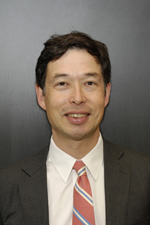













.jpg)
















